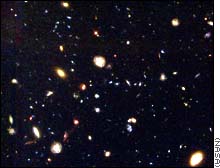
|

|
||||
A recent Hubble image, known as the Deep Field South, showing a 12
billion-light-year corridor filled with thousands of never-before-seen
galaxies
|
||||
May
25, 1999
Web posted at: 11:47 a.m. EDT (1547 GMT)
BALTIMORE, Maryland (CNN) -- A team of scientists working with the Hubble Space Telescope said Tuesday they have calculated the answer to one of astronomy's most hotly debated questions: how old is the universe?
Answer: 12 billion years old.
The Hubble Team worked under the premise that the key to determining the age of the universe was to calculate an accurate value for the Hubble Constant -- the rate at which the universe has been expanding since the Big Bang.
If they can measure how fast the universe is expanding, astronomers say, they can then simply work backward to determine how long ago the Big Bang occurred.
Pinpointing the Hubble Constant was one of the three primary scientific goals set forth by astronomers when they launched the Hubble Space Telescope almost 10 years ago.
"Before Hubble, astronomers could not decide if the universe was 10 million or 20 billion years old," astronomer Wendy Freedman of the Carnegie Observatories in Pasadena, California, said in a statement. "The size scale of the universe had a range so vast that it didn't allow astronomers to confront with any certainty many of the most basic questions about the origin and eventual fate of the cosmos,"
Freedman is leader of the Hubble Space Telescope Key Project Team, a group of researchers who announced the finding Tuesday. The team has been studying the universe's age for eight years.
To measure the Hubble Constant, the astronomers studied a type of pulsating star called a Cepheid variable, which can be used to accurately measure intergalactic distances.
In short, Cepheid stars are of a standard brightness. Think of them as light bulbs of identical wattage. Distance is the only factor that changes the relative brightness of a Cepheid star -- the further away from Earth it is, the dimmer it appears.
The Hubble Team studied almost 800 Cepheid stars, in 18 galaxies, as far away as 65 million light years. In this manner, the team used the stars to calibrate a number of different distance measuring techniques that they then put to work measuring how fast galaxies are speeding away from each other.
Astronomers with the Key Project Team said they've calculated the expansion rate to within 10 percent accuracy. In the end, they came up with a value of 70 kilometers per second per megaparsec (a megaparsec is 3.26 million light years -- and a light year is about 5.9 trillion miles). This means that a galaxy appears to be moving 160,000 mph faster for every 3.3 light-years away from Earth. And that means the Universe was born 12 billion years ago.
"The truth is out there, and we will find it," said Dr. Robert Kirshner of Harvard University in a statement. "We used to disagree by a factor of two; now we are just as passionate about 10 percent. A factor of two is like being unsure if you have one foot or two. Ten percent is like arguing about one toe. It's a big step forward."
Other members of the Hubble Space Telescope Key Project Team include Dr. Jeremy Mould, professor of astronomy at the Australian National University; and Dr. Michael S. Turner, chairman of the Department of Astronomy and Astrophysics at the University of Chicago.